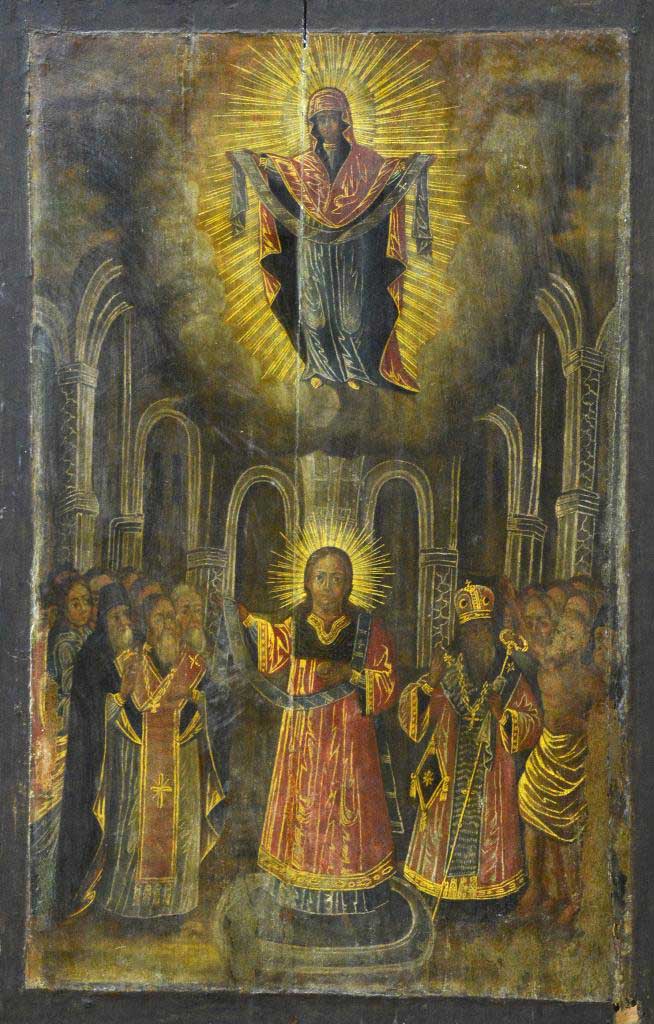  #Exhibit of the Month #Exhibit of the Month
October 2022
Icon of the Protection of the Mother of God
 Several icons from the collection of the National Museum of History of Moldova reproduce in their compositions the miracle that would have been performed around the beginning of the 10th century in the church of Mother of God of Vlacherne in Constantinople. According to the legend, the townspeople retreated to the place for fear of an invasion that threatened the capital of the empire. The gathered crowd prayed incessantly, asking the Blessed Virgin to save the city. In the church of Vlacherne, her ancient vestments, which are said to make miracles, have been preserved for centuries. Among the Christians praying in the church was Saint Andrew the Fool-For-Christ, who came with his disciple Epiphanius, who would later become the Patriarch of Constantinople Polyevkt. After hours of fervent prayers, Saint Andrew was worthy to see the Mother of God passing through the royal doors with a procession of saints, who rose above the crowd, praying together with those present. In the end, the Blessed Virgin spread her garment over the crowd, as a sign of defense and protection, leaving the place. Also, from the legend we know that the city was really saved then.
Several icons from the collection of the National Museum of History of Moldova reproduce in their compositions the miracle that would have been performed around the beginning of the 10th century in the church of Mother of God of Vlacherne in Constantinople. According to the legend, the townspeople retreated to the place for fear of an invasion that threatened the capital of the empire. The gathered crowd prayed incessantly, asking the Blessed Virgin to save the city. In the church of Vlacherne, her ancient vestments, which are said to make miracles, have been preserved for centuries. Among the Christians praying in the church was Saint Andrew the Fool-For-Christ, who came with his disciple Epiphanius, who would later become the Patriarch of Constantinople Polyevkt. After hours of fervent prayers, Saint Andrew was worthy to see the Mother of God passing through the royal doors with a procession of saints, who rose above the crowd, praying together with those present. In the end, the Blessed Virgin spread her garment over the crowd, as a sign of defense and protection, leaving the place. Also, from the legend we know that the city was really saved then. Later, in memory of this miracle, the Church will order the Feast of the Protection of the Mother of God, celebrated on October 1/14. The composition of the exposed icon highlights the interior of the Vlacherne church. In the upper register, in a radiate oval mandorla, the Mother of God soars on the clouds, holding the omophorus in her hands. She wears loose robes, trimmed with gold thread, beneath which red, gilded shoes can be seen. In the lower register, in the center of the gathered crowd, Romanos the Melodist is depicted sitting on the pulpit with the timetable in his hands, his head being framed by a radiant nimbus. He is dressed in festive robes, of the same shades as the vestments of the Mother of God. Romanus the Melodist is surrounded by several ecclesiastical faces and simple people, including Saint Andrew, who urges his disciple Epiphanie to look up at the miracle that was taking place in the church. The appearance of the hymnographer Romanos the Melodist (490-556) in this composition is not accidental. The young deacon began his activity in the Vlacherne church, where, five centuries later, Saint Andrew experienced his miraculous revelation. The legend tells that it was the Mother of God who endowed the young man with the grace of a wonderful voice, he later glorified her in his songs, writing, in all probability, the Akathist Hymn of the Mother of God. The Church commemorates Romanos the Melodist on October 1/14, the same day when the Protection of the Mother of God is commemorated. The icon comes from the 19th century, from one of the workshops in southern Russia, being painted in tempera on a wooden support with dimensions 59x90x3 cm.
|
 31 August 1989 St., 121 A, MD 2012, Chisinau, Republic of Moldova
31 August 1989 St., 121 A, MD 2012, Chisinau, Republic of Moldova




 The side panels are elegantly decorated with refined cast-iron elements in the Art Nouveau style, displaying the brand name - "Ideal." The Polyglott model, featuring a bilingual keyboard patented in the United Kingdom by Max Klaczko from Riga, Latvia, was produced between 1902 and 1913, marking the first typewriter capable of writing in two languages. The "Ideal Polyglott" typewriter was actively sold in the Russian Empire and gained significant popularity in Poland, Bulgaria, and Serbia.
The side panels are elegantly decorated with refined cast-iron elements in the Art Nouveau style, displaying the brand name - "Ideal." The Polyglott model, featuring a bilingual keyboard patented in the United Kingdom by Max Klaczko from Riga, Latvia, was produced between 1902 and 1913, marking the first typewriter capable of writing in two languages. The "Ideal Polyglott" typewriter was actively sold in the Russian Empire and gained significant popularity in Poland, Bulgaria, and Serbia.













































